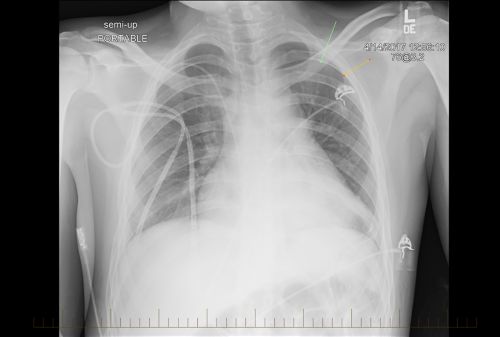What is non-Hodgkin lymphoma?
Non-Hodgkin lymphoma (NHL) is the name for a group of lymphomas that are not Hodgkin lymphoma.
Lymphomas begin in lymphocytes. These white blood cells are part of the body's immune system. They can travel through the body in the bloodstream or in a fluid called lymph that moves through lymph vessels.
Lymph drains into the bloodstream using the body's lymphatic system. This system includes the lymph vessels, lymph nodes, tonsils, thymus, bone marrow, and spleen.
Because lymph travels through the body, lymphoma can start in many places, such as:
- Lymph nodes
- Thymus gland
- Spleen
- Abdomen
- Liver
- Bone marrow
- Skin
- Bones
Symptoms of non-Hodgkin lymphoma
Risk factors for non-Hodgkin lymphoma
Risk factors may increase your child’s chances of getting a disease. Little is known about the risk factors for NHL in children. The risk factors we know so far are:
- Weak immune system after a bone marrow or solid organ transplant
- Infection with Epstein-Barr virus or human immunodeficiency virus (HIV)
- A genetic disorder such as ataxia-telangiectasia
- More common in males than females
- More common in White than Black children
Diagnosis of non-Hodgkin lymphoma
If the pathologist finds lymphoma cells in the biopsy sample, the lab will perform more lab tests on the sample. These may include flow cytometry, immunophenotyping, and cytogenetic analysis, if these tests are available.
Stages of non-Hodgkin lymphoma
The care team plans treatment based on the cancer stage. Some tumors grow rapidly, so lymphoma must be staged as quickly as possible.
To find out the stage of NHL, doctors may order more tests such as:
The stage will tell how severe the cancer is, and if it has spread to other parts of the body.
The International Pediatric Non-Hodgkin Lymphoma Staging System divides the diseases into 4 stages:
- Stage 1 and 2 lymphomas are limited-stage disease. The treatment for both stages is similar.
- Stage 3 and 4 lymphomas are advanced-stage disease. The treatment for both stages is similar, but the length of treatment may vary depending on the stage.
Treatment of non-Hodgkin lymphoma
NHL can be aggressive in children, so treatment must start as soon as possible. More aggressive treatment is needed in higher stages of cancer.
Treatment depends on:
- Type of lymphoma
- Stage of lymphoma
- How well it may respond to treatment
- Available treatments
- Patient age and health
NHL treatment may include:
The treatment plan for some types of NHL depends on how the lymphoma responds when treatment begins. This approach is known as risk-adapted therapy. Doctors choose therapy based on how well cancer responds to treatment.
- Patients whose lymphoma responds well to treatment may get fewer medicines and possibly fewer side effects.
- Patients whose lymphoma does not respond as well often require stronger therapies.
- All patients get medicines and other therapies to help manage side effects.
Your child’s doctor will discuss treatment options with your family.
About 10–30% of NHL patients have a disease that is hard to treat or that comes back after treatment. Treatment options depend on the type of disease and may include:
Some patients may be able to take part in a clinical trial to test a new treatment.
Prognosis for non-Hodgkin lymphoma
The prognosis for NHL depends on many factors. Your care team is the best source of information about your child's prognosis.
In the United States, about 800 new cases of NHL are diagnosed in children and teens each year. NHLs in children are different from those found in adults. Childhood lymphomas can spread faster to other parts of the body. Yet, these cancers are often highly treatable. Survival depends on individual factors, but the overall survival rate for children and teens in the United States is good (near 90%).
NHL research focuses on:
- Making new targeted therapies and immunotherapy to improve survival rates
- Reducing and stopping the late effects of therapy, such as infertility, heart problems, and subsequent cancers
- Finding the genetic changes that cause childhood lymphoma, which help doctors:
- Identify the type of disease
- See how patients respond to treatment
- Develop new treatments that target genetic problems and their effects on the body
Support for patients with non-Hodgkin lymphoma
Coping with a cancer diagnosis and treatment can be stressful for the patient and the family. You may want to talk to a social worker, a psychologist, or another mental health specialist.
Learn more about how to talk to your child about cancer.
After treatment, your child's doctor may use imaging tests and exams to watch for recurrence. Childhood cancer survivors should get long-term follow-up care. Some treatments can cause late effects. These are health problems that happen months or years after the end of their treatment.
After completing treatment, it is important that your child:
- Has regular checkups and screenings by a primary care provider
- Maintains healthy habits to protect their health, including physical activity and healthy eating
- Has a survivorship care plan to share with their health providers, which includes:
- Guidance on health screenings
- Disease risk factors
- How to improve health
Questions to ask your care team
Find out more information


